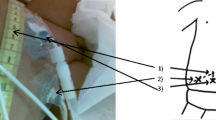Abstract
Objective
To determine glucose balance during dextrose-free continuous hemodiafiltration with or without dextrose-containing ultrafiltrate replacement fluid and full nutritional support.
Design
Prospective, nonrandomized, observational study.
Setting
A 24-bed multiple trauma critical care unit in a level-I trauma center.
Patients
Seventeen multiple trauma patients with multiple organ dysfunction syndrome requiring hemodialysis for acute renal failure.
Interventions
Continuous hemodiafiltration effluent volume and glucose concentration were measured. Study days were classified according to whether dextrose was used in the ultrafiltrate replacement therapy. Use of dextrose in replacement therapy was determined clinically. Parenteral nutrition was not altered for potential glucose absorption from continuous hemodiafiltration. Ultrafiltrate replacement consisted of 5% dextrose in saline on 21 study days (D5YES) and dextrose-free solutions on 54 study days (D5NO).
Results
The D5YES group received 316±145 g glucose/day from the ultrafiltrate replacement fluid, in addition to glucose in total parenteral nutrition (total glucose intake=942±229 g/day in D5YES, 682±154 g/day in D5NO) (p<0.05). Glucose loss in continuous hemodiafiltration effluent was 82±61 g/day in D5YES and 57±22 g/day in D5NO (P<0.05), for a net glucose uptake of 8.1±2.1 mg/kg per min in D5YES and 5.4±1.5 mg/kg per min in D5NO (p<0.05). Glucose loss was predictable when dialysate and ultrafiltrate replacement fluids were dextrose-free (R 2=0.77), but less so when dextrose was used as ultrafiltrate replacement (R 2=0.47).
Conclusion
Dextrose-free dialysate promotes glucose loss during continuous hemodiafiltration, but the loss is small and predictable. Use of a dextrose-containing ultrafiltrate replacement fluid results in a significant increase in glucose intake without a commensurate increase in glucose loss, and makes glucose loss in effluent less predictable.
Similar content being viewed by others
References
Reynolds HN, Borg U, Belzberg H, Wiles CE III (1991) Efficacy of continuous arteriovenous hemofiltration with dialysis in patients with renal failure. Crit Care Med 19: 1387–1394
Davenport A, Will EJ, Davidson AM (1993) Improved cardiovascular stability during continuous modes of renal replacement therapy in critically ill patients with acute hepatic and renal failure. Crit Care Med 21: 328–338
Schetz M, Lauwers PM, Ferdinande P (1989) Extracorporeal treatment of acute renal failure in the intensive care unit: a critical review. Intensive Care Med 15: 349–357
Bellomo R, Martin H, Parkin G, Love J, Kearley Y, Boyce N (1991) Continuous arteriovenous haemodiafiltration in the critically ill: influence on major nutrient balances. Intensive Care Medicine 17: 399–402
Bellomo R, Colman PG, Caudwell J, Boyce N (1992) Acute continuous hemofiltration with dialysis: effect on insulin concentration and glycemic control in critically ill patients. Crit Care Med 20: 1672–1676
Members of the American College of Chest Physicians/Society of Critical Care Medicine Consensus Conference Committee. American College of Chest Physicians/Society of Critical Care Medicine Consensus Conference (1992) Definitions for sepsis and organ failure and guidellines for the use of innovative therapies in sepsis. Crit Care Med 20: 864–874
Long CL, Schaffel N, Geiger JW et al (1979) Metabolic response to injury and illness. Estimation of energy and protein needs from indirect calorimetry and nitrogen balance. JPEN 3: 452–456
Greenspan L, McLellan BA, Greig H (1985) Abbreviated injury scale and injury severity score: a scoring chart. J Trauma 25: 60–64
Anderson J, Johnson G, Jarvis C, Strausburg K, Moore F (1993) Clinical utility of a dialysate solution containing dextrose 0.1% in patients receiving CAVHD and TPN (abstract). Presented at the American Society for Parenteral and Enteral Nutrition 17th Clinical Congress, Feb 14–17
Long CL, Blakemore WS, Merrick H, Grecos G, Dennis R, Hall T (1985) Effect of carbohydrate intake on respiratory quotients and energy expenditure in septic patients. Fed Proc 44: 1146
Shaw JHF, Klein S, Wolfe RR (1985) Assessment of alanine, urea, and glucose and in patients with sepsis with stable isotopic tracers. Surgery 97: 557–568
Burke JF, Wolfe RR, Mullany CJ et al (1979) Glucose requirements following burn injury. Ann Surg 190: 274–285
Elwyn DH, Kinney JM, Jeevanandam M, Gump FE, Broell JR (1979) Influence of increasing carbohydrate intake on glucose kinetics in injured patients. Ann Surg 190: 117–127
Lowry SF, Brennan MF: Abnormal liver function during parenteral nutrition (1979) Relation to infusion excess. J Surg Res 26: 300–307
Nordenstrom J, Jeevanandam M, Elwyn DH et al (1989) Increasing glucose intake during total parenteral nutrition increases norepinephrine excretion in trauma and sepsis. Clin Physiol 1: 525–534
Elwyn DH (1989) The unique role of glucose in artificial nutrition: Impact of injury and malnutrition. Clin Nutr 7: 195–202
Monaghan R, Watters JM, Clancey SM et al (1993) Uptake of glucose during continuous arteriovenous hemofiltration. Crit Care Med 21: 1159–1163
Author information
Authors and Affiliations
Rights and permissions
About this article
Cite this article
Frankenfield, D.C., Reynolds, H.N., Badellino, M.M. et al. Glucose dynamics during continuous hemodiafiltration and total parenteral nutrition. Intensive Care Med 21, 1016–1022 (1995). https://doi.org/10.1007/BF01700664
Received:
Accepted:
Issue Date:
DOI: https://doi.org/10.1007/BF01700664




